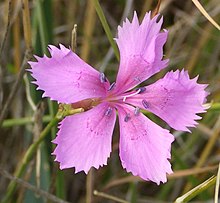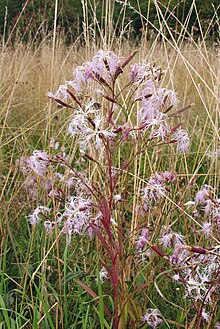Dianthus
| Dianthus | |
|---|---|

| |
| Dianthus caryophyllus flower | |
| Scientific classification | |
| Kingdom: | |
| (unranked): | |
| (unranked): | |
| (unranked): | |
| Order: | |
| Family: | |
| Genus: | Dianthus |
| Type species | |
Dianthus is a genus of about 300 species of flowering plants in the family Caryophyllaceae, native mainly to Europe and Asia, with a few species extending south to north Africa, and one species (D. repens) in arctic North America. Common names include carnation (D. caryophyllus), pink (D. plumarius and related species) and sweet william (D. barbatus).
Description
The species are mostly herbaceous perennials, a few are annual or biennial, and some are low subshrubs with woody basal stems. The leaves are opposite, simple, mostly linear and often strongly glaucous grey-green to blue-green. The flowers have five petals, typically with a frilled or pinked margin, and are (in almost all species) pale to dark pink. One species, D. knappii, has yellow flowers with a purple centre. Some species, particularly the perennial pinks, are noted for their strong spicy fragrance.
Taxonomy
Subdivision
Selected species;
|
Hybrids include;
- 'Devon Xera' - Fire Star Dianthus[1]
- 'John Prichard'
Etymology
The name Dianthus is from the Greek words Διός Dios ("of Zeus") and ἀνθός anthos ("flower"), and was cited by the Greek botanist Theophrastus. The color pink may be named after the flower, coming from the frilled edge of the flowers: the verb "to pink" dates from the 14th century and means "to decorate with a perforated or punched pattern". As is also demonstrated by the name of "pinking shears", special scissors for cloth that create a zigzag or decorative edge that discourages fraying.
Ecology
Dianthus species are used as food plants by the larvae of some Lepidoptera species including Cabbage Moth, Double-striped Pug, Large Yellow Underwing and The Lychnis. Also three species of Coleophora case-bearers feed exclusively on Dianthus; C. dianthi, C. dianthivora and C. musculella (which feeds exclusively on D. suberbus).



Cultivation
Dianthus species have been extensively bred and hybridised to produce many thousands of cultivars for garden use and floristry, in all shades of white, pink, yellow and red, with a huge variety of flower shapes and markings. They are often divided into the following main groups:-[2][3]
- Border carnations - fully hardy, growing to 60 cm (24 in), large blooms
- Perpetual flowering carnations - grown under glass, flowering throughout the year, often used for exhibition purposes, growing to 150 cm (59 in)
- Malmaison carnations - derived from the variety 'Souvenir de la Malmaison', growing to 70 cm (28 in), grown for their intense "clove" fragrance
- Old-fashioned pinks - older varieties; evergreen perennials forming mounds of blue-green foliage with masses of flowers in summer, growing to 45 cm (18 in)
- Modern pinks - newer varieties, growing to 45 cm (18 in), often blooming two or three times per year
- Alpine pinks - mat-forming perennials, suitable for the rockery or alpine garden, growing to 10 cm (4 in)
Over 100 varieties have gained the Royal Horticultural Society's Award of Garden Merit.[4]
Culture
Dianthus gratianopolitanus - the Cheddar Pink - was chosen as the County flower of Somerset in 2002 following a poll by the wild flora conservation charity Plantlife.[5] "Dianthus Japonicus" is the official flower of Hiratsuka City, Kanagawa Japan.
See also
Gallery
-
White cultivar of Dianthus barbatus
-
Dark red cultivar of Dianthus barbatus
-
D. caryophyllus
-
Dianthus monspessulanus
-
Carnation D. monspessulanus
-
Red D.caryophyllus
-
Dianthus caryophylus (red)
-
D.caryophyllus seed heads
-
Dianthus shinanensis
References
- ^ Missouri Botanical Garden
- ^ RHS A-Z encyclopedia of garden plants. United Kingdom: Dorling Kindersley. 2008. p. 1136. ISBN 1405332964.
- ^ Leslie, A.C. (2012). The International Dianthus Register (1983) & Checklist: Twenty-ninth Supplement. Royal Horticultural Society.
- ^ Royal Horticultural Society
- ^ Plantlife website County Flowers page'.'










